Pennsylvania turnpike bridge project races against the clock
29 March 2023
Rapid Bridge Replacement continues to be a time-effective solution for keeping U.S. highway systems open and flowing smoothly while allowing necessary repairs to the highway infrastructure.
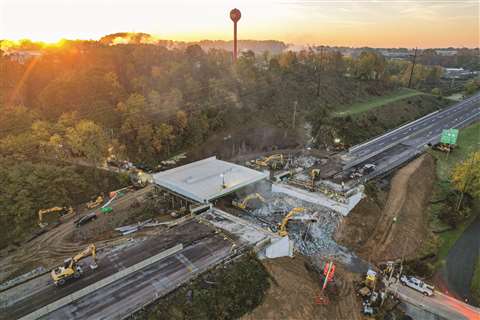 Buckingham Heavy Transport mobilized its equipment to the staging area, completed a test run and proceeded with the bridge replacement.
Buckingham Heavy Transport mobilized its equipment to the staging area, completed a test run and proceeded with the bridge replacement.
In the fall of 2022, Buckingham Heavy Transport assisted with the replacement of an 80 by 72-foot bridge span on the I-476 corridor in Pennsylvania’s Lehigh Valley. Due to the volume of traffic on I-476, time management was essential. Buckingham was challenged with a 12-hour window in which to complete the proposed bridge slide.
Buckingham Heavy Transport’s office management partnered with its sister manufacturing company, Buckingham Structural Moving Equipment, to engineer a straightforward slide solution that would allow the project to be completed well within the time constraints of the project.
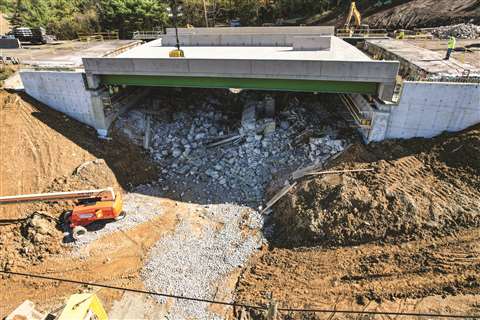 While the general contractor cleared away the demolition debris from the old bridge, the Buckingham team placed 20 hydraulic jacks on the north and south temporary abutments and positioned them beneath the bridge girders.
While the general contractor cleared away the demolition debris from the old bridge, the Buckingham team placed 20 hydraulic jacks on the north and south temporary abutments and positioned them beneath the bridge girders.
After the initial job proposal was accepted, the Buckingham team met with the general contractor and engineering firm to discuss the details. Procedure and quality control plans were presented and included cut sheets for the custom fabricated equipment designed by Buckingham Equipment. The new bridge section would be manufactured in place on temporary abutments beside the old bridge section, which was scheduled for demolition just prior to placement of the new one.
High tonnage jacks
Buckingham’s proposal entailed positioning high tonnage jacks at each end of the bridge’s ten girders; these would be connected via hydraulic hoses to two unified jacking machines. Data cables linking the two unified jacking machines would lift the 20 jacks in perfectly synchronized motion, allowing precise stabilization and control of its placement.
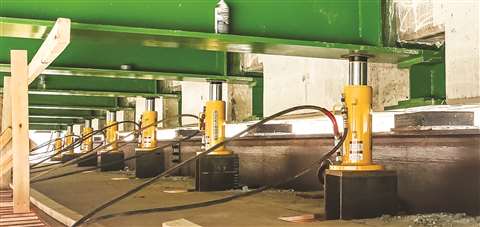 Once the hydraulic hoses and data cables were connected, the unified jacking machines smoothly lifted the bridge section for the placement of the X/Y skates, which were clamped to the bridge girders and the steel slide beams.
Once the hydraulic hoses and data cables were connected, the unified jacking machines smoothly lifted the bridge section for the placement of the X/Y skates, which were clamped to the bridge girders and the steel slide beams.
When the bridge was lifted, Buckingham would install bidirectional X/Y skates under each end of the girders and use two custom bridge clamps and push rams to slide the 825,000-pound bridge section over the permanent concrete abutments, where the 20 hydraulic jacks would be used a second time to lower it to final position on the new bearings.
Test run completed
After the Pennsylvania Turnpike Commission had given final approval on the plans, Buckingham mobilized its equipment to the staging area, completed a test run and proceeded with the bridge replacement. The project was scheduled on a Saturday morning to lessen traffic disruptions.
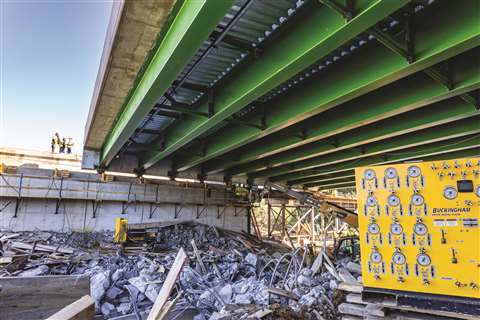 The Y layers of the skates were positioned to allow lateral adjustment of the bridge section’s final position if necessary.
The Y layers of the skates were positioned to allow lateral adjustment of the bridge section’s final position if necessary.
While the general contractor cleared away the demolition debris from the old bridge, the Buckingham team placed the 20 hydraulic jacks on the north and south temporary abutments and positioned them beneath the bridge girders. The hydraulic hoses and data cables were connected, and the unified jacking machines smoothly lifted the bridge section for the placement of the X/Y skates, which were clamped to the bridge girders and the steel slide beams.
The Y layers of the skates were positioned to allow lateral adjustment of the bridge section’s final position if necessary. Buckingham installed the custom bridge clamps holding the push-rams, which fastened to the ends of the bridge abutments and used hydraulic clamps to grip the steel slide beams while the push rams slid the bridge section forward.
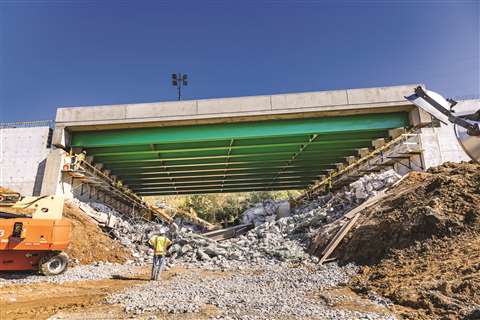 The bridge was safely installed in six hours.
The bridge was safely installed in six hours.
While the bridge section moved over the span of the transfer beams, Buckingham workers transferred the 20 high tonnage jacks to the permanent abutment seats.
When the bridge section had completed the 100-foot transfer, they lifted the bridge, removed the skates and lowered the bridge section into final position.
Project manager Aaron Smith said, “Utilizing the Buckingham unified jacking machine with push rams and XY skates was the perfect combination of equipment for the bridge movement. It allowed us to maintain precise control in the north/south direction, as well as make minute adjustments as needed for east/west orientation as we rolled the bridge section into place.”
Ahead of schedule
Buckingham Heavy Transport completed the process safely and the bridge replacement took a total of six hours, allowing the turnpike to reopen ahead of schedule.




